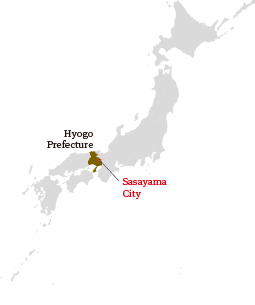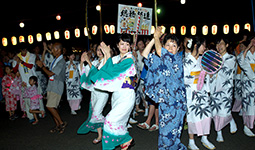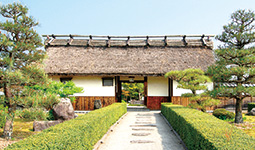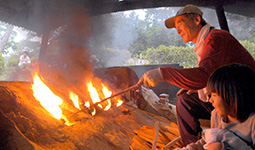Home > Highlighting JAPAN > Highlighting Japan September 2016 > Japan Heritage
Highlighting JAPAN
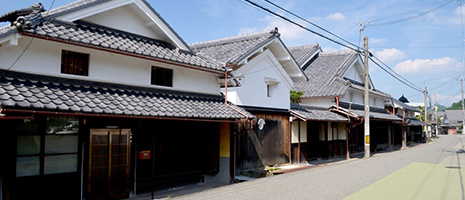
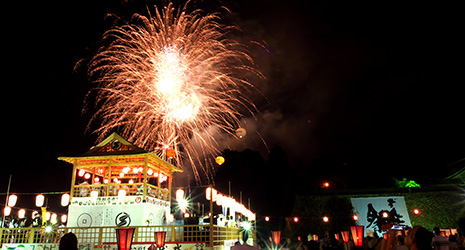
- PREVIOUS
- NEXT
Yoi Yoi Dekansho!
The people of Sasayama in Hyogo Prefecture have been passing down and adapting their famous local folk song — the “great, great” “Dekansho Bushi” — for many, many years.
The city of Sasayama (population: approx. 45,000), also known as Tanba-Sasayama, is located in a mountainous area of Hyogo Prefecture approximately one hour north of Osaka by train. Here the well known folk song called the “Dekansho Bushi” (lit. Dekansho Song) has been handed down and enjoyed for centuries.
The song was originally sung by local farmers at the time of the Bon Festival in the early Edo period (1603–1867). Later, in the Meiji period (1868–1912), students from Sasayama taught the song to their friends in Tokyo, thereby expanding the recognition of the simple, singable melody nationwide.
“The lyrics of the ‘Dekansho Bushi’ speak of the culture, history, sights and specialties of Tanba-Sasayama,” says Tatsuaki Koyama of Sasayama’s Creative City Division. “A major difference from regular folk songs is the annual additions to the lyrics. The song now has nearly 300 verses.”
The many verses of “Dekansho Bushi” are short — each can be sung within 30 seconds or so — and they are full of humor.
One of the best-known refrains is, “Tanba-Sasayama yamaga-no saru-ga hana-no oedo-de shibai suru.” This phrase literally means that a monkey (saru) from the bosom of a mountain (yamaga) in Tanba-Sasayama is faring successfully in the gorgeous city of Edo (now Tokyo). It is a self-mocking tale in other words of a “local boy made good.”
The people of Tanba-Sasayama dance to the “Dekansho Bushi” at their summer festivals. The largest of these is the Dekansho Festival, which is held annually on August 15 and 16. Celebrating its 64th anniversary this year, the Dekansho Festival takes place in the remains of Sasayama Castle and attracts nearly 100,000 people over a two-day period. The festival reaches its climax with around 1,000 people dancing in a circle around the yagura stage built at the center of the venue, with fireworks coloring the night sky. New additions to the lyrics of the “Dekansho Bushi,” selected annually from public submissions, are also unveiled at the festival.
“In Sasayama, the ‘Dekansho Bushi’ is taught at elementary schools, which means that everyone in the town knows how to sing it,” says Koyama. “The local people aspire to sing and dance around the yagura at the Dekansho Festival.”
In Tanba-Sasayama, some of the cultures and landscapes mentioned in the original “Dekansho Bushi” survive to this day. One example of this is the pottery called Tanba-yaki. Dating back to the late twelfth century, Tanba-yaki originated in the Konda-cho district of Sasayama. Today, more than sixty potters are active in the town. The potters sell their works and offer pottery workshops in their studios. The Museum of Ceramic Art, Hyogo collects and exhibits Tanba-yaki and other pottery from the prefecture, and also organizes a workshop using the oldest Tanba-yaki climbing kiln in existence today, which was built in 1895.
In the Edo period, the Fukusumi district was a post town along the road connecting Sasayama with Kyoto, and it bustled with many travelers and merchants. A number of residences and storehouses from the period remain in excellent condition here, and Fukusumi has duly been designated as an Important Preservation District for Groups of Traditional Buildings.
A villa belonging to the Aoyamas, the family that governed Sasayama in the Edo period, remains in the Aoyama History Village and exhibits materials related to the family. The Tanba-Sasayama Dekansho Kan, a museum that opened in the Village in April this year, recreates the dekansho dance with the use of augmented reality (AR).
“Sasayama is not very far from Kyoto or Osaka, but it is altogether more relaxed here,” says Koyama. “This is a great place in which to appreciate the atmosphere of a traditional country town.”
- PREVIOUS
- NEXT
© 2009 Cabinet Office, Government of Japan
